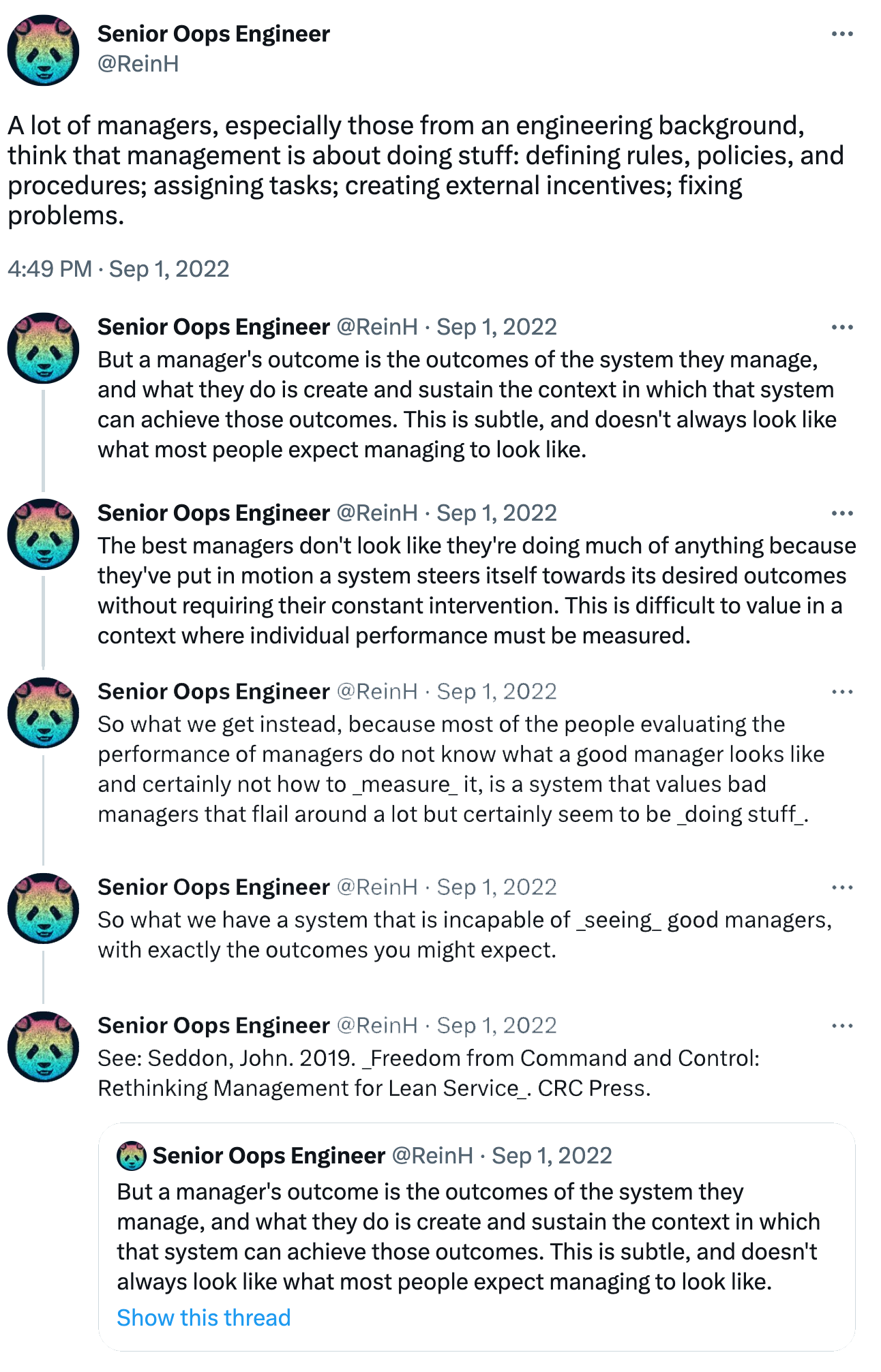Management and Systems Thinking
ಹಲೋ ವರ್ಲ್ಡ್ (“Hello World” in Kannada)
We’re on the second-to-last chapter of It Depends! Once I finish serializing the book in the newsletter, I’ll have a few bonus newsletters to answer some of the questions I’ve received. If you would like to ask me a question, please send it to contact@itdependsbook.net.
About this week’s chapter
The most senior leaders I know possess a profound understanding of Systems Thinking and the systems that exist within their companies. It is nearly impossible to evolve organizations or build and execute strategies without this understanding.
Many leaders have developed this knowledge organically over time, without formally linking it to Systems Thinking literature or practices. Those leaders may be successful in their organizations, but will struggle to find their footing if they change organizations until they can once again build their new mental models organically.
Leaders who understand the formal principles of Systems Thinking have a scaffold they can use to get up to speed in a new organization much more quickly. They can “see the matrix” that underlies the relationships and informal processes of new organizations they encounter.
Beyond making a plea to other leaders to study Systems Thinking principles, this chapter also shares some of the challenges I faced while trying to evolve new systems in my prior roles. The situations I describe as hypothetical in the chapter are real experiences I had where I was either successful or unsuccessful in evolving existing systems. In the podcast episode featuring this chapter, I provide more details about those experiences.
This is Chapter 23 of "It Depends."
Management and Systems Thinking
Originally published on September 17, 2022
“Until managers take into account the systemic nature of their organizations, most of their efforts to improve their performance are doomed to failure.”
-Dr. Russell Ackoff
I came across a Twitter thread from Rein Henrichs about management, and I thought it also had many good points about systems thinking.
It caused me to reflect on my approach to systems thinking in the context of technical leadership.
One of the things that helped me the most as an engineering leader was developing a better understanding of systems thinking. When I (or others) use the analogy of “planting a garden” when setting up teams for success, this is what we mean. We are creating the system to enable groups and individuals to do their best work and then allow good behaviors (and results) to emerge. Of course, creating a system takes longer than pushing things down into the organization. Still, it produces more creativity and autonomy in the organization, making it more resilient to change or challenges.
Managers who do not work with this understanding of systems think that management is purely about doing stuff: defining rules, policies, and procedures, assigning tasks, creating external incentives, and fixing problems. This “doing stuff” approach can produce good results in small teams or for a constrained amount of time.
As Rein Henrichs also correctly points out, building a system can be incomprehensible for others in the organization who are not directly involved (especially in other more transactional disciplines). This lack of understanding has often been my biggest challenge as a company’s senior engineering leader.
Building a system takes time. If you can get things to a good place where the system is starting to be self-perpetuating, the rest of the organization will see the improvements and become supporters.
Suppose the leadership team is impatient and doesn’t understand what you are trying to do. In that case, senior leadership will lean into the quick fixes listed above, re-organization or replacing individuals or trying to “drive accountability” through reductive top-down control mechanisms.
If that happens, you are stuck trying to mitigate the damage and build a longer-term plan to return to your original goals, but it is often a losing battle. This is because the primary culture of the organization has re-asserted itself, and your chance to evolve it has mostly gone.
How do you avoid that fate?
Communicate! Make your plans clear in the hiring process, your initial days in the organization, and throughout the process. Set realistic timelines for improvement and celebrate the successes along the way. When your peers are impatient, refocus them on the plan and the long-term gains you are working towards. Point to the achievements thus far and try to keep their “eyes on the prize.”
Will this always work?
No. It depends on the company’s situation and how much pressure there is on the leadership team. If the company is stressed, it might be better to refocus on shorter-term solutions that don’t actively detract from what you are trying to build.
My biggest successes in companies were getting the entire organization on board with the system I was working to build. Gaining support for a new system of working is a culture change, and getting backing is contingent on the company wanting to change. If the company is on a “burning platform,” a situation where change is required for the company to grow or survive, you will find less resistance. A burning platform also provides the inspiration to persevere if the change is difficult.
My biggest failures trying to build systems were when I did not communicate my intentions clearly or did not get buy-in from the rest of the leadership team, or when I was not effective at communicating the improvements along the way.
Another challenge can be a change (losing a customer or a tough quarter) that puts pressure on the leadership team. In this case, you need to adapt quickly. Hopefully, the system you are putting in place encourages being nimble. You may need to pause the change to the system to focus on shorter-term tactical solutions. To minimize the disruption in the organization, be transparent about the need for the change, and set an expectation on how you will get reoriented towards your original vision afterward.
While there are many good books on systems thinking, the one I consistently recommend for engineering leaders is Management 3.0 by Jurgen Appelo. It isn’t just about systems thinking but weaves it into a broader book about management.
The Latest Podcast
In this episode titled “The Myth of the Startup in a Large Company,” I am joined by my longtime friend and peer Kevin Stewart, SVP of Engineering at Splice, to challenge the familiar but flawed narrative: that a team inside a big company can "operate like a startup." Drawing on our shared experiences at Adobe and divergent paths through startups, we explore why innovation often stalls inside large organizations and what makes real startup environments fundamentally different. This wide-ranging conversation explores culture, risk, incentives, and why resource contention, rather than imagination, hinders corporate innovation.
I shared this chapter in the newsletter last July.
You can download the episode from Apple Podcasts, Spotify, YouTube, directly via the RSS Feed, or wherever you listen to podcasts (see pod.link for a more extensive list).
About this newsletter
What makes this newsletter unique is that every two weeks, I share a chapter from my book It Depends: Writing on Technology Leadership 2012-2022, which Unit Circle Press released in March of last year. These chapters are not sequential; each is a standalone piece. In addition, a podcast serializes the audiobook in order, released alternate weeks from this newsletter.
Reader Survey
I’m thinking about what happens to this newsletter and the podcast after we complete the book. I want your help! Please complete a very quick and anonymous survey to help me out.
Thanks again for reading! If you find it helpful, please share it with your friends.
Buy on Amazon | Buy on Bookshop.org | Buy on Audible | Other stores




